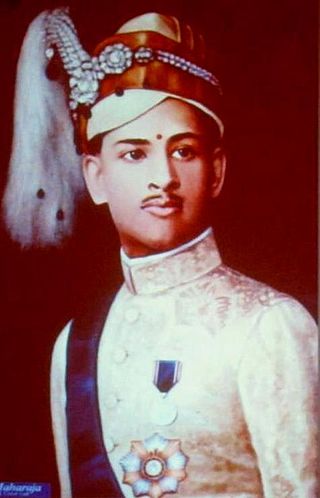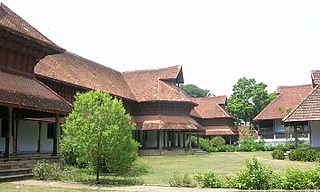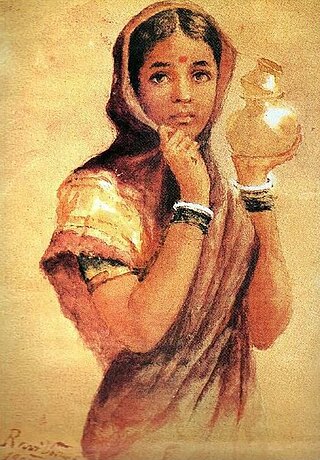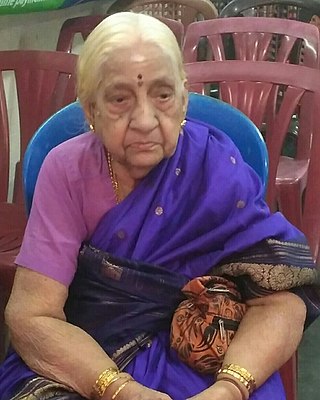
Thiruvananthapuram, formerly known as Trivandrum, is the capital city of the Indian state of Kerala. It is the largest and most populous city in Kerala. The encompassing urban agglomeration population is around 1.68 million. Located on the west coast of India near the extreme south of the mainland, Thiruvananthapuram is a major information technology hub in Kerala and contributes 55% of the state's software exports as of 2016. Referred to by Mahatma Gandhi as the "Evergreen city of India", the city is characterised by its undulating terrain of low coastal hills.

The Kingdom of Travancore, also known as the Kingdom of Thiruvithamkoor or later as Travancore State, was kingdom that lasted from c. 1729 until 1949. It was ruled by the Travancore Royal Family from Padmanabhapuram, and later Thiruvananthapuram. At its zenith, the kingdom covered most of the south of modern-day Kerala and the southernmost part of modern-day Tamil Nadu with the Thachudaya Kaimal's enclave of Irinjalakuda Koodalmanikyam temple in the neighbouring Kingdom of Cochin. However Tangasseri area of Kollam city and Anchuthengu near Attingal in Thiruvananthapuram were parts of British India.

Sree Padmanabhadasa Sree Chithira Thirunal Balarama Varma, popularly known as Sree Chithira Thirunal, was the last ruling Maharaja of the Indian princely state of Travancore, in southern India until 1949 and later the Titular Maharajah of Travancore until 1991. His reign is known for several notable reforms that have indelible impact on the society and culture of Kerala.

Thiruvananthapuram District is the southernmost district in the Indian state of Kerala. The district was created in 1949, with its headquarters in the city of Thiruvananthapuram, which is also Kerala's administrative centre. The present district was created in 1956 by separating the four southernmost Taluks of the erstwhile district to form Kanyakumari district. The city of Thiruvananthapuram is also known as the Information technology capital of the State, since it is home to the first and largest IT park in India, Technopark, established in 1990. The district is home to more than 9% of total population of the state.
The history of Thiruvananthapuram dates back to the 18th century AD. In 1795, the city became the capital of the princely state of Travancore. Several historic landmarks of the city, including the Kowdiar Palace, University of Kerala, and Napier Museum were built during that period. After independence, Thiruvananthapuram was made the capital of the state of Kerala.

The city of Thiruvananthapuram has been the centre of cultural activities of Kerala (India) from the time it was made capital of Travancore in 1745. The capital city is a major intellectual and artistic center. The Thiruvananthapuram Museum and Thiruvananthapuram Zoo were started during the reign of Swathi Thirunal (1813–1847) and are one of the oldest of their kind in India. The city's libraries include the Trivandrum Public library, which was started in 1829. The Swathi Thirunal College of Music and 'College of fine arts' are the leading institutions related to music and arts.

Kerala State Road Transport Corporation (KSRTC) is a state-owned road transport corporation in the Indian state of Kerala. It is one of the country's oldest state-run public bus transport services. The corporation is divided into three zones, and its headquarters is in the state capital Thiruvananthapuram. Daily scheduled service has increased from 1,500,000 kilometres (930,000 mi) to 1,700,000 kilometres (1,100,000 mi), using 5400 buses on 4500 routes. The corporation transports an average of 3.545 million commuters per day.

Kulathupuzha is a town in the eastern part of Kollam district of Kerala, India. It is one of the important pilgrim spots linked with the legend of Sabarimala. It is the birthplace of the Malayalam music composer Raveendran. Kulathupuzha is the source of the Kallada river, Thenmala Dam (KIP) is located on this river. As declared by the Governor Arif Mohammad Khan, Kulathupuzha panchayat is the first in India to have achieved Constitution-literacy.

The Thiruvananthapuram Zoo is located in the city of Thiruvananthapuram, the capital of Kerala, India. It occupies 55 acres (22 ha) of woodland, lakes, and lawns.

Kuthiramalika is a palace built by Swathi Thirunal Rama Varma on the south-eastern side of Padmanabhaswamy temple, Thiruvananthapuram.

Sri Padmanabha DasaSir Sri Visakham Thirunal Rama Varma VFRAS, also known as Rama Varma the Learned, was the Maharaja of Travancore from 1880 to 1885 AD, succeeding his elder brother Ayilyam Thirunal on the musnud, or throne. He was a noted scholar of Sanskrit and literary composer in Malayalam, who reversed his brother's policy, liberally patronizing poet Kerala Varma, while hostile to painter Raja Ravi Varma.
Pattom is a dense commercial region of Thiruvananthapuram city in Kerala, India. It is located approximately 4 kilometres north of centre of Thampanoor. Pattom is largely a residential area, also housing few important administration offices of Kerala State and a few shopping complexes. It has offices of Kerala Public Service Commission, Kerala State Planning Board, Life Insurance Corporation of India, Thiruvananthapuram Divisional Office, LIC Housing Finance Limited, State Resource Centre, District Panjayat Headquarters, Fire and Rescue Department Headquarters, Kerala Co-operative Milk Marketing Federation (Milma), Employees Provident Fund Regional Office and Kerala State Electricity Board. The Traffic Police and Telecommunication department, and the Kerala Science, Technology and Environment Head Office are also located in Pattom.

Kanakakkunnu Palace is situated in Thiruvananthapuram near the Napier museum, India. It served as an official residence for Sir C.P. Ramaswami Iyer during his dewanship, in addition to Bhakti Vilas and Padma Vilas.

Sree Chitra Art Gallery is an art gallery in Thiruvananthapuram, India, established in 1935. It is located in the northern grounds of the Napier Museum. It was inaugurated by Chithira Thirunal Balarama Varma. The gallery features a unique collection of traditional and contemporary paintings, including the works of Raja Ravi Varma, Nicholas Roerich, Svetoslav Roerich, Jamini Roy, Rabindranath Tagore, V. S. Valiathan, C. Raja Raja Varma, and K. C. S. Paniker. There are approximately 1100 paintings at the gallery.

Tiruvalla railway station is an NSG–3 category Indian railway station in Thiruvananthapuram railway division of Southern Railway zone. It is one of the busiest railway station in Thiruvananthapuram Central-Kollam-Kottayam-Ernakulam route, located at Thiruvalla town in Pathanamthitta district, Kerala, India. Tiruvalla is the only railway station in the Pathanamthitta District. The station is under Thiruvananthapuram railway division of Southern Railway. It is an NSG 3 category station and has daily trains to cities like Thiruvananthapuram, Kochi, Kozhikode, Mangalore, Bangalore, Coimbatore, Madurai, Chennai, Hyderabad, Tirupati, Pune, Bhopal, Mumbai and New Delhi.

Parassala B. Ponnammal was an Indian Carnatic musician from the south Indian state of Kerala. She was a classical carnatic vocalist in the lineage of Semmangudi Srinivasa Iyer, Muthiah Bhagavathar, and Papanasam Sivan. She was the first woman to perform at the Navaratri Mandapam in Thiruvananthapuram as a part of the Navaratri Celebrations of the Sri Padmanabhaswamy temple in Kerala.

Job Kurian is an Indian singer and composer who works in both indie music and in Malayalam films. He won the South Indian International Movie Award for Best Male Playback Singer in Malayalam in 2023.

Dr. M. G. Sasibhooshan is an orator, writer, art historian, and consultant in Indology based in Thiruvananthapuram, Kerala, India.

















